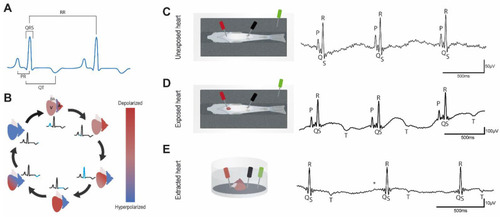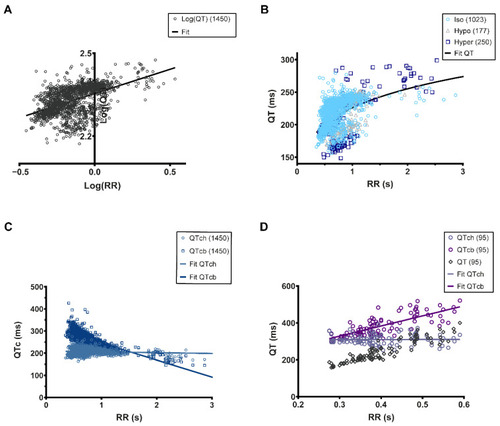FIGURE SUMMARY
- Title
-
The Effect of Hypothermia and Osmotic Shock on the Electrocardiogram of Adult Zebrafish
- Authors
- Arel, E., Rolland, L., Thireau, J., Torrente, A.G., Bechard, E., Bride, J., Jopling, C., Demion, M., Le Guennec, J.Y.
- Source
- Full text @ Biology (Basel)
|
Figure 1. ECG representation and typical recordings; (A), Schematic representation of the interval measurement method. We chose to take the peak of the P and T waves to determine PR and QT intervals respectively to reduce the uncertainty of the measurements when taking before P waves or after T waves; (B), Cartoon representing the different depolarization and repolarization steps of the zebrafish heart cavities. A: atrium, V: ventricle, BA: bulbus arteriosus; (C–E), Schematic representation of the electrode positioning in the different configurations and representative traces; (C), Unexposed heart; (D), Exposed heart; (E), Extracted heart, * indicates putative P wave. Traces show three consecutive ECG complexes after application of a 50 Hz low-pass filter.
|
|
Figure 2. QT-RR relationship in different configurations of ECG measurement. (A), Unexposed heart; (B), exposed heart; (C), extracted heart. The number of individual QT-RR pairs, obtained in isosmotic, hyposmotic, and hyperosmotic conditions, is presented in the upper right corner of each graph and was obtain from n = 3 (unexposed heart), n = 10 (exposed heart), and n = 6 (extracted heart) adult zebrafish.
|
|
Figure 3. QT-RR relationship in different configurations of ECG measurement. (A), Unexposed heart; (B), exposed heart; (C), extracted heart. The number of individual QT-RR pairs, obtained in warm and cool conditions is presented in the upper right corner of each graph and was obtain from 5 (unexposed heart), 9 (exposed heart) and 7 (extracted heart) fish.
|
|
Figure 4. QT-RR relationship fitting. (A), Linear fitting (black line) of the Log(QT)–Log(RR) relationship). The slope of the relationship is 0.2064; (B), Non-linear fitting (black line) of the QT-RR relationship using the characteristics of the fitting shown in (A); (C), QTc-RR relationship using Holzgrefe’s correction formula (QTch) and Bazett’s equation (QTcb). These relationships were linearly fitted (blue-grey line: QTch; navy line: QTcb); (D), QT-RR relationship from the data published in Milan et al., 2006. The QT-RR raw data are in open black diamonds. The QT corrected by the Holzgrefe’s equation, QTch, are lilac opened circles, and the corresponding linear fitting is the lilac line, while the QT corrected by Bazett’s formula are opened purple circles and the corresponding linear fitting if the purple line. The number of individual QT-RR pairs is presented in the upper right corner of each graph.
|
Acknowledgments
This image is the copyrighted work of the attributed author or publisher, and
ZFIN has permission only to display this image to its users.
Additional permissions should be obtained from the applicable author or publisher of the image.
Full text @ Biology (Basel)




